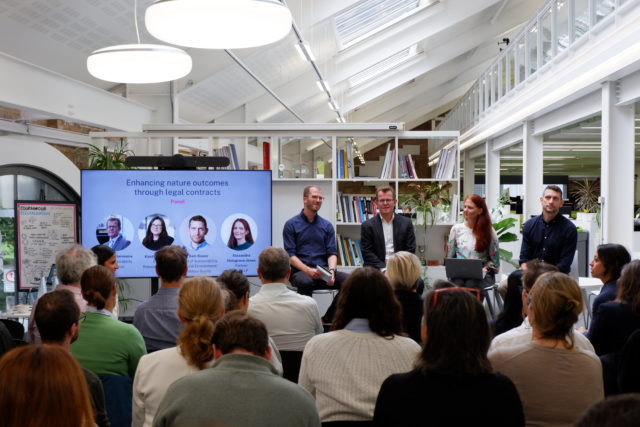News & Insights
How contracts can deliver nature-positive outcomes: reflections from our event

Event summary
Alongside our friends at Hoare Lea and the UK Green Building Council (UKGBC), we were delighted to host a breakfast event: Enhancing Nature-Positive Outcomes Through Legal Contracts. Over 50 built environment professionals joined us to explore how contracts can become tools for embedding nature-positive action.
Held at Hoare Lea’s King’s Cross offices, the event combined lightning talks from Macarena Cardenas PhD, Senior Sustainability Advisor at UKGBC, and Meena Kamath, Head of Built Environment at The Chancery Lane Project, and a lively panel discussion, featuring four fantastic speakers:

Key takeaways
Here are five practical lessons from the day.
- Be specific: Clauses must be clear, measurable, and actionable. Vague commitments like “the parties will work together on nature” need defined KPIs, goals, and accountability. Core ambition shouldn’t be lost during negotiation.
- Nature-positive doesn’t cost more: We heard innovative examples of nature-based flood defences, like attenuation ponds, being used to reduce flood risk and enhance habitats and public space at no extra cost.
- Contracts can be collaborative: They can create friendly accountability, incentivise cooperation, and remind parties of shared ambitions.
- Not all timber is created equal: certified timber, sourced from forests with stewardship obligations, can deliver both carbon and biodiversity gains and contracts can provide the framework to ensure careful sourcing.
- Start now: Don’t wait for perfect industry standards. Contracts are being constantly renewed or signed, so embed these provisions now and then to test, improve, and increase ambition over time.
“The challenge is not only to reduce harm, but to actively regenerate and restore. We need systems that work for both people and nature,” said Macarena Cárdenas PhD, UKGBC.
Why nature-positive matters now
More than half of global resource extraction, land-use change and material demand is driven by construction, which can disrupt ecosystems and damage biodiversity.
As Macarena Cárdenas (UKGBC) reminded us, the challenge for the built environment is not only to reduce this harm, but to actively regenerate and restore. That requires legal, social, and economic systems that support people, strengthen the economy and protect the natural world.
Her provocation set the tone: how do we ensure that the systems we rely on truly work for people and nature?
Contracts as catalysts for change
Contracts already shape how every project is delivered. While regulation sets the minimum standard, contracts can go further by embedding stronger, binding commitments that drive climate and nature action.
For example, if a project aims to reduce embodied carbon by using mass structural timber, the contract can stipulate conditions that ensure nature is not compromised. This could be achieved by requiring suppliers only to source timber from responsibly managed, regenerative forests. This way, developers can support biodiversity and forest health well beyond their building or city.
Contracts already exist in every project, so the challenge for the industry, and its legal advisers, is how to use them to drive accountability and embed climate and nature commitments.
Putting nature-positive commitments into practice
At The Chancery Lane Project, our focus is on decarbonisation clauses. Working with nature experts from UKGBC, Hoare Lea and beyond, this event marked the beginning of exploring how carbon clause concepts can be applied to nature in contracts. Together, we began to consider what this could mean in practice.
Our speakers were clear in their message: contracts should be used as enablers to change, not barriers. Used well, they can turn high-level aspirations into binding commitments that drive measurable outcomes for nature.
The conversations also reflected the importance of shared definitions. Once published, UKGBC’s Nature Positive Built Environment Framework will provide a useful reference point – clarifying scope, responsibilities, and actions that stakeholders can align on. This guidance will be vital to developing meaningful nature contract clauses.
A huge thank you to Hoare Lea for hosting us, to UKGBC for co-delivering, and to our incredible speakers for their thought-provoking contributions. And above all, thank you to everyone who joined us and brought their expertise, questions, and energy to the morning.
What can you do next?
Translating nature-positive goals into contracts is an emerging area, and we don’t yet have dedicated nature clauses. Watch out in the coming weeks for part two of this blog, which will explore these challenges in more depth and consider what future nature clauses could look like. In the meantime, you can:
- Share your feedback: If you attended our event, we’d love to know your reflections by filling out this short survey.
- Learn more: Take our online course to learn how to use contracts to drive positive environmental outcomes. The skills you will gain – from drafting clear, measurable clauses to embedding accountability – can be applied to protecting and restoring nature in your projects.
Clauses: Many of our contractual concepts featured in our template clauses can be adapted to address nature-related risks and opportunities beyond GHG emissions.
